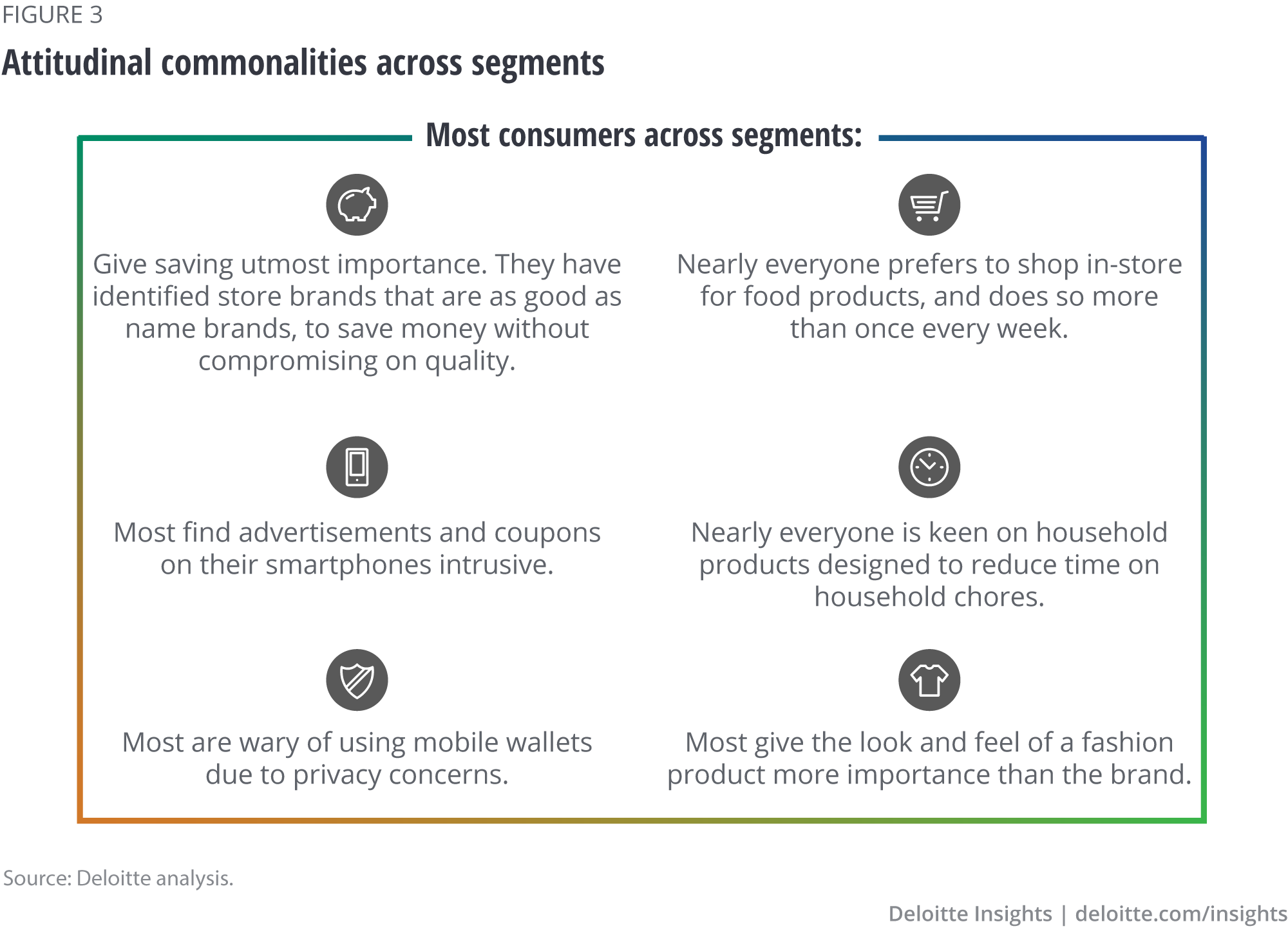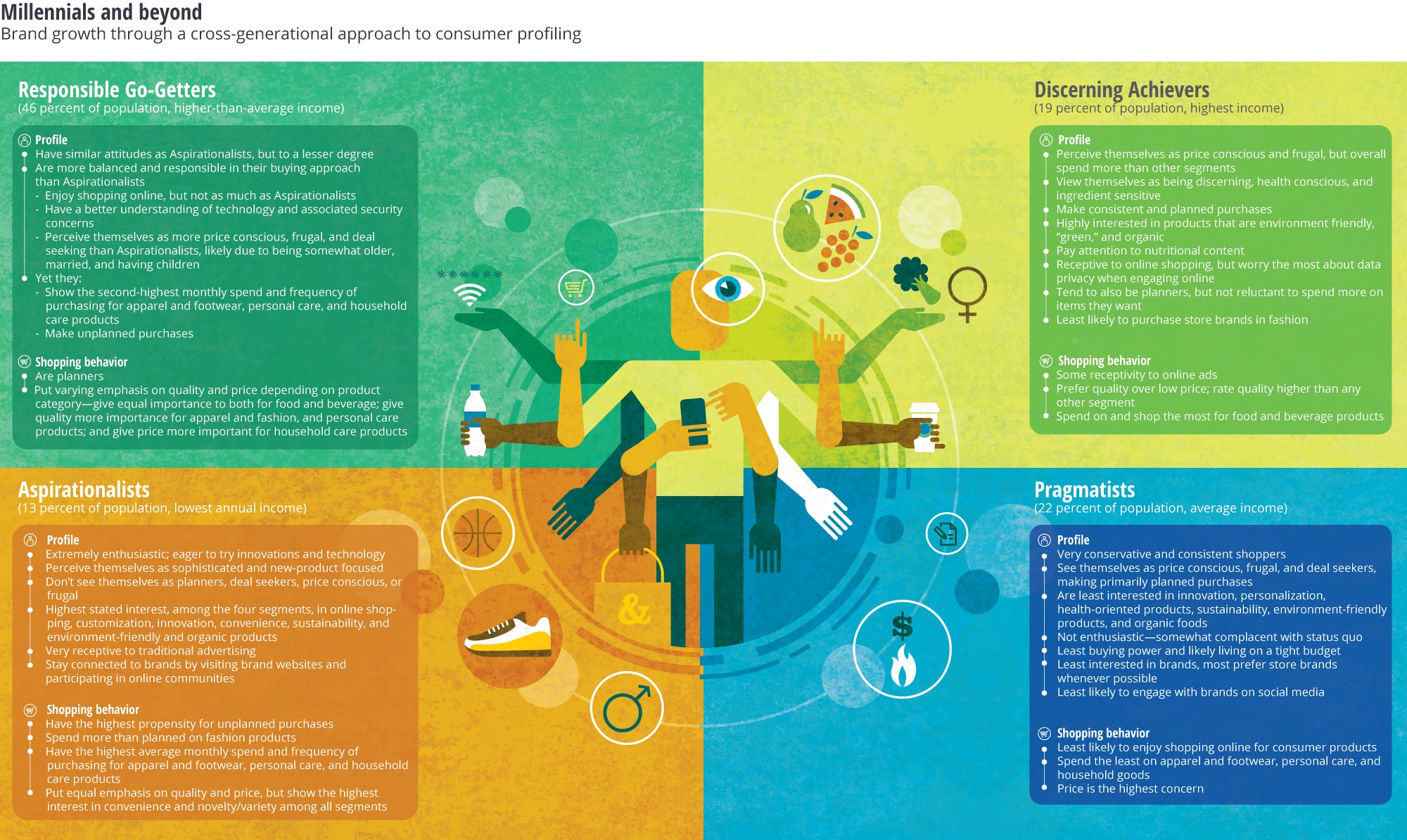
Millennials and beyond Brand growth through a cross-generational approach to consumer profiling
13 minute read
28 July 2018
Millennials aren’t so vain that they think a pitch is about them. Marketers often generalize consumer profiles, an approach that can be overly myopic. There are ways to avoid taking a stereotypical view of consumers and deploying a more nuanced approach.
Avoiding a stereotypical view of consumers
Every day, most Americans wake up to coffee. According to a 2017 National Coffee Association report, most Americans drink coffee regularly, together fueling a US$13 billion national industry.1 The report goes on to suggest that more millennials favor gourmet coffee, specifically espresso-based beverages—a variant also preferred by many Generation Z adults—and that baby boomers are significantly more partial
Learn more
Read more from the marketing and sales collection
View the infographic
Subscribe to receive related content
In a hurry? Read a brief version from Deloitte Review, issue 24
Download Deloitte Review, issue 24
to instant and decaf coffee than other generations.2 Generation X, in contrast, seems to be wavering slightly in its commitment to coffee, with many lured away by alternative caffeinated beverages and health drinks.3
Some baby boomers reading this may be thinking, “Wait, I drink espresso and gourmet coffee all the time.” Conversely, if you are a millennial, you may eschew espresso and consume vast quantities of alternative caffeinated beverages.
This example from the coffee category suggests a bigger point: Not all commonly held beliefs about generations are true, and clinging to stereotypical beliefs about each age group can limit profitability and growth. Today, all generations are exposed to the same disruptive forces of globalization, innovation, technology, and the social media revolution, causing a melding of attitudes and behaviors. Thus, it’s typically important for consumer-marketing organizations to take a more nuanced approach to profiling their target consumers by delving deeper into consumer attitudes and shopping behavior. This can help capture revenue from consumer segments that may go unrecognized and untargeted based solely on generational marketing.
In this report, we present a refined approach to understanding consumers according to a segmentation method that relies not merely on age, but also on individuals’ expressed attitudes toward shopping and their self-reported actions.
A focus on millennials potentially masks the importance of other generations
Many consumer products organizations are investing significant marketing and innovation dollars in millennials,4 and Generation Z is also emerging as a significant target.5 Much has been written about the attitudes, behavior, and preferences of these generations. However, a heightened marketing focus on millennials shouldn’t blind companies to the potential appeal of older generations, often with greater spending power. From a marketing perspective, stereotyping generations vis-à-vis broadly held attitudes on innovation, wellness, convenience, technology, and marketing tactics can lead to missed opportunities arising from a deeper and more comprehensive view of consumers. These could result in less productive outcomes and inefficient use of marketing resources.
In particular, it would be wise to note the equally formidable size and greater buying power of baby boomers (23.5 percent of the US population in 2016) and Generation X (20.3 percent) compared to millennials (24.7 percent) and Generation Z (21.5 percent).6 Given their high buying power and despite their shrinking size, older generations will likely continue to exercise enormous influence in the market as their needs and circumstances evolve. A Deloitte study, The future of wealth in the United States,7 asserts that baby boomers will continue to be the wealthiest generation in the United States until at least 2030. It also purports that Generation X will see the highest increase in the share of national wealth through the forecast period—from under 14 percent in 2015 to 31 percent by 2030.
Segmentation by attitudes: A more nuanced approach to profiling consumers
Segmentation by attitudes may not only help break down stereotypes, but could also show commonalities across segments that do not warrant any differentiation from a marketing point of view. It can present a fresh and nuanced approach to companies in addressing strategic questions such as:
- Who are my current customers? How similar or different are they?
- What is their buying behavior? Do they prefer online shopping to in-store shopping, or vice versa?
- Which segment has the most potential in terms of size, frequency of purchase, and brand involvement with my product?
- What’s the best way to communicate with each segment? What message will resonate with them? What’s their preferred medium?
Our analysis of consumer responses revealed four distinct segments: Aspirationalists, Responsible Go-Getters, Pragmatists, and Discerning Achievers. These segments are described in more detail in the infographic, and figures 1 and 2.
Click here to view the infographic fullscreen.
 The segments are derived by applying advanced statistical analysis (cluster analysis) to 75 attitude statements addressing consumers’ shopping behavior, channel preferences and attitudes toward innovation, brand, convenience, health and wellness, and technology relating to purchasing consumer products. Interestingly, the segments we identified cut across generations, indicating that attitudes are not hardwired by generations. Consequently, even though each segment may be dominated by one or two age groups, we see presence of consumers across all age groups by virtue of similarity in their behavior.
The segments are derived by applying advanced statistical analysis (cluster analysis) to 75 attitude statements addressing consumers’ shopping behavior, channel preferences and attitudes toward innovation, brand, convenience, health and wellness, and technology relating to purchasing consumer products. Interestingly, the segments we identified cut across generations, indicating that attitudes are not hardwired by generations. Consequently, even though each segment may be dominated by one or two age groups, we see presence of consumers across all age groups by virtue of similarity in their behavior.
That said, the segmentation presented in this report is meant to be illustrative rather than definitive. Organizations may want to consider developing their own approach to segmenting customers according to relevant attitudes and behaviors to develop an in-depth understanding of their consumers.

Segment summaries emphasize each segment’s predominant characteristics. Figure 3 describes a few noteworthy attitudinal commonalities across segments.

Addressing generational stereotypes: Separating myths from facts
In the light of how media can often portray different generations in stereotypical ways, we have identified eight commonly held myths in four key areas where consumer products companies may want to reconsider their marketing strategies, given our survey results and learnings from cross-generational segmentation. These common myths are organized around key themes of shopping behavior, brand loyalty, brand engagement, and brand growth.
Shopping behavior
Myth #1: Generation Z predominantly shops online.
Generation Z does not shop online the majority of the time. In fact, the mix of in-store and online shopping sways in favor of shopping in physical stores for all age groups, including Generation Z, most of whom, as per survey results, report shopping in a physical store for food and beverages (68 percent of the time), household care products (58 percent), and personal care items (51 percent). The only category where they predominantly favor online channels is apparel and footwear. This may be especially unexpected from this generation that was born and brought up in the digital era.
Our nuanced consumer segmentation revealed that it is Aspirationalists who have the greatest propensity to shop online for consumer products. While this segment tends to comprise younger people, survey results showed that it also includes a sizable 28 percent of like-minded older consumers. Aspirationalists then present a potentially more profitable target for online shopping than simply Generation Z consumers.
Even as interest in online shopping continues to grow across age groups, marketing organizations may need to revisit their channel strategies for signs of generational typecasting. Marketing organizations would likely benefit from pursuing an omni-channel marketing strategy that does not compromise consumers’ in-store experience, while pursuing online excellence. There are numerous ways organizations will likely benefit by improving their digital connection with consumers.8 Understanding how the segments vary in their preferred store formats and whether any segment’s channel choices vary by product category can help consumer products marketing organizations strike the right balance of channels.
Myth #2: Only younger consumers describe themselves as health-conscious, worry about nutrition, and buy organic foods.
Simple generational analysis might suggest that Generation Z and millennials should be the primary targets for health-oriented products, and innovations in this area would likely target them. The attitudinal consumer segmentation gives a slightly different account: Our survey results reveal that while Aspirationalists, a relatively young segment, tend to lead the way in actively avoiding products with preservatives, artificial sweeteners, and other chemicals, they are very closely followed in their overall concern for health by Discerning Achievers, many of whom are significantly older.
Even as our survey results show that eight in 10 Aspirationalists actively seek organic products for consumption, Discerning Achievers lead other segments in perceiving themselves as health-conscious, ingredient-sensitive, and “homemade”-ingredients-driven. They also give more importance to nutritional content and spend more on food and beverage items than other segments, possibly because of their interest in healthy food options. These insights demonstrate that Discerning Achievers are playing a large role in driving the health-oriented food market.
As most consumer products organizations move toward healthier products and ingredients, sustainable sourcing, and informative labeling, marketing organizations would likely benefit by targeting Discerning Achievers to promote health-oriented food items. With regard to innovation, marketing organizations could address the attributes Discerning Achievers most desire, understanding whether these attributes signal the advent of a new trend and effectively conveying them through marketing communications.
Myth #3: Across age groups, value seekers are only the less affluent.
Regardless of segment and income, our survey results found that consumers rate value as an important consideration, putting it immediately after quality and price. Indeed, consumers with moderate-to-high annual income consistently perceive themselves as being more price-conscious, deal-seeking, and frugal than those earning less than US$50,000 annually.
With that perspective, our segmentation approach underlines how the concept of value can apply differently to each group of consumers. For instance, in the case of the affluent Discerning Achievers, who can and do spend more on consumer products, value typically lies in quality. For Pragmatists, value is generally all about low price.
For all consumers, regardless of segment or income level, it’s generally not just cost or quality, but rather a balance of the two that delivers value. Through consumer segmentation, marketing organizations can map the value proposition of individual consumer products to the expectations of their target consumers and increase product appeal.
Brand loyalty
Myth #4: Younger generations are no longer interested in traditional brands.
Study results reveal that interest in brands is alive and well—over 85 percent of the Aspirationalists, who tend to be younger than the other segments, believe the brands they buy say a lot about who they are, while 87 percent report purchasing name brands. In key areas of health foods, nutrition, and grooming products, we found that Aspirationalists—despite earning the lowest—prefer well-known name brands over store brands, likely because they are averse to taking risks with these products. Ironically, it’s the Discerning Achievers and Pragmatists who were found to be less interested in brands, having grown to accept store brands, except often in the case of apparel and footwear.
Consumers typically choose store brands for practical reasons such as price, familiarity, and availability. They tend to pick name brands for emotional reasons such as loyalty and trust. The good news for name brands is that, even though store brands are becoming more competitive due to improved quality, interest in name brands among younger generations seems to remain. This likely bodes well for brands and the future of brand differentiation. To help generate brand growth, marketing organizations could focus on extending brand reach and reinforcing brand relevance among younger consumers.
Brand engagement
Myth #5: Traditional advertising channels do not appeal to younger generations. Social media is the best way to reach them.
Just as “brands” seem alive and well, so too are traditional media channels of TV and Print. Our study results reveal that more Aspirationalists (83 percent) enjoy watching advertisements on TV than Pragmatists (18 percent) and Discerning Achievers (12 percent). Further, when questioned about use of traditional advertisements and promotions, most Aspirationalists (89 percent) and Responsible Go-Getters (69 percent) claimed in the survey that newspaper and TV make them aware of products they want to buy. Remarkably, they have a similar attitude toward online and retail store advertisements and promotions.
This seems to dispel another closely related commonly held notion that social media is the only way to reach younger generations. Despite the rapid rise and predominance of social media, survey results found that traditional media remains a popular channel to engage with younger consumers.
When considering marketing channels to reach younger consumers, most marketing organizations would do well to consider a balance of traditional and social media platforms. Overreliance on social media may unintentionally leave out a sizable opportunity to influence young population that consumes traditional media.
Myth #6: Older generations do not use social media.
Our study results indicate that most consumers, age aside, have exposure to a minimum of one social media platform at least once in the day. Every day, over seven in 10 consumers in each segment engage on Facebook, while YouTube is the second most popular social-media destination. Discerning Achievers are found to be very involved with social media; they typically use it differently than younger segments.
With the cross-generational influence of social media established, let us see how social media is leveraged for engagement. Consumer segmentation points the way here: Aspirationalists and Responsible Go-Getters were found to use social media to both research product information and post feedback. They also often engage with brands on a deeper level by staying connected through online communities. Discerning Achievers and Pragmatists generally do not generate content on social media, but use social media to read reviews and product ratings before purchasing new products.
Social media gives marketing organizations an untapped opportunity to build brand relationships with older consumers, especially because they use social media differently. Perhaps it would be beneficial to have marketing strategies that lead older consumers to post product experiences, and reward them with coupons, loyalty points, etc. The opinions posted by this group would likely play a role in influencing the younger consumers, most of whom admit to relying on the opinions of family and friends when making purchases.
Myth #7: Only older generations use coupons and discounts.
Though most of the Aspirationalists claim they do not have much time to bother with coupons or promotions, our survey results revealed that more than seven in 10 consumers across segments enjoy exploring how much money they can save by using coupons or loyalty cards. In our survey result, this proportion is, in fact, considerably higher for Aspirationalists and Responsible Go-Getters, the two segments predominantly composed of younger consumers.
Aspirationalists and Responsible Go-Getters are among those looking for savvy ways to maximize their spend. Marketing organizations could address this need by developing targeted couponing programs and discounts. To increase their appeal, these plans should be made novel and exciting. Loyalty points for participating in brand-engagement activities, gamification drills, and other experiential marketing activities could possibly work well with Aspirationalists and Responsible Go-Getters.
Brand growth
Myth #8: Innovation and brand growth are only fueled by younger generations.
Older Discerning Achievers with higher buying power potentially have the ability to drive brand growth in the immediate future. Thus, while younger Aspirationalists and Responsible Go-Getters may be more interested in innovation, it does not mean that the other segments are not worth targeting. In fact, in terms of interest in emerging technologies in general, Discerning Achievers were found to closely follow Aspirationalists and Responsible Go-Getters. Specifically, they exhibit a considerably high level of interest in innovations such as customized products and smart packaging. Thus, based on their behavior and higher income levels, Discerning Achievers should be considered a viable target for innovation and brand growth.
Furthermore, Discerning Achievers typically assign high importance to quality across consumer products categories. This is often reflected in their store choices as well. They tend to shop more than others in specialty food stores, and a considerable proportion purchases apparel and footwear from boutique stores. Even in the luxury marketplace, as pointed out in the Deloitte study Global Powers of Luxury Goods 2017, the young are merely shaping the landscape, and it’s ultimately the older, more affluent consumers that stand out with their greater spending impact.9
Marketing organizations should map their newer, bolder brand-growth strategies to the various cross-generational segments, especially Discerning Achievers, given their buying power and interest in innovation. If marketers can demonstrate the value proposition of their offering to Discerning Achievers, this segment can contribute significantly to brand growth.
Putting it together: Driving brand growth through a nuanced approach to consumer profiling
Marketing organizations can avoid the pitfalls of stereotypical marketing strategies by identifying the dominant segments that drive business results. Contrary to general belief, these segments are not merely defined by generation. The four attitude-based, cross-generational consumer segments we introduce in this report represent a more nuanced approach to profiling consumers. Analysis of eight pervasive myths appears to reveal not only untapped potential segments, but also glaring commonalities across cross-generational segments.
The new segments have potential implications for brand growth, and companies can modify their marketing strategies accordingly to maximize results. This approach could potentially serve as an important enabler in meeting profitability goals and maintaining loyalty among dominant consumer segments. It potentially makes the case for expanding into new segments to foster innovation-driven revenue and brand growth, and achieving sales and revenue from consumer segments one wouldn’t approach based solely on generational marketing. Study results reveal that when deciding on a marketing strategy, there is scope for prioritization, even among the attitudinal segments.

Responsible Go-Getters, primarily comprising millennials and Generation X, are the most valuable segment for consumer products companies. They generally exhibit attitudes that are considered balanced and responsible, be it general enthusiasm, purchasing behavior, or awareness and usage of technology. They are an appealing target for marketing organizations, given Responsible Go-Getters’ above-average buying power and interest in seeking value. They are more likely to be brand loyal if they see value. Figure 4 illustrates the sheer size of the Responsible Go-Getter segment that amplifies the amount they spend on consumer products every year—it’s the highest by an impressive margin.
This insight might come as a surprise after the discussion on the attitudes and behaviors of the relatively younger Aspirationalists and the spending power of older Discerning Achievers. Study results indicate that it tends to be millennials with Aspirationalist attitudes that have garnered media and marketing attention. Marketing organizations are potentially missing a larger opportunity with millennials who are a part of the Responsible Go-Getters segment.
Discerning Achievers, dominated by baby boomers and Generation X, are a strong secondary target. On average, they are the most affluent group, spending the most on consumer products. Even though they are a smaller segment than Responsible Go-Getters, their buying power, coupled with their high expectations regarding quality and ability to actually purchase innovative products, suggests that they are a highly attractive target for marketing organizations.
The perception that baby boomers are not interested in innovation, technology, etc., is likely due to baby boomers who are Pragmatists, and not due to those who are the more progressive Discerning Achievers, the untapped segment.
Our survey results indicate that the other two segments, Pragmatists and Aspirationalists, are close in terms of their average-to-low spend on consumer products, rendering them more challenging prospects for marketing organizations. What tends to separate Pragmatists from Aspirationalists is the reason for lower spend vis-à-vis age. Pragmatists, comprising primarily Generation X consumers, have felt the brunt of the economic downturn of 2009 during their prime earning years. Aspirationalists, comprising Generation Z adults, are in the early phase of their careers.
For now, due to the difference in their sizes, Pragmatists seem to have a slight edge in terms of marketing potential. As for the future, Aspirationalists could lead the way on innovation and technology, keeping growth prospects alive for consumer products companies, assuming their buying power catches up with their aspirations.
By developing a more refined approach to understanding consumers, marketing organizations can initiate more inclusive brand growth, likely driving profitability. Marketing strategies based on attitudes and shopping behavior will likely be more appealing to consumers. Attitudinal segmentation can result in a more thoughtful targeting, and can help develop unique innovative products that are more effective with customers. Consumer products marketing organizations would likely benefit by testing how the findings and implications of this study resonate with their brands and strategies by developing their own proprietary segmentation schemes. One place to begin is by considering questions related to understanding a brand’s current buyer segmentation, and then defining potential target consumers in terms of both age cohorts and consumer attitudes.
© 2021. See Terms of Use for more information.
More on millennials
-
What weighs on millennials’ minds … and wallets? Article6 years ago
-
Decoding millennials in the gig economy Article7 years ago
-
Don’t want to lose your Gen Z and millennial talent? Here’s what you can do Article2 years ago
-
Are we headed for a poorer United States? Article7 years ago













